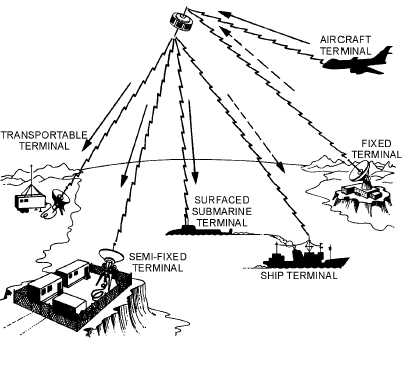4-3
Figure 4-1.—Satellite communications system.
DESCRIPTION OF COMMUNICATIONS SATELLITE SYSTEM
The basic design of a satellite communications system depends to a great degree upon the
characteristics of the orbit of the satellite. In general terms, an orbit is either elliptical or circular in shape.
A special type of orbit is a SYNCHRONOUS ORBIT. In this type you will find the period (time required
for one revolution) of the orbit the same as that of the earth. An orbit that is not synchronous is called
ASYNCHRONOUS. A period of orbit that approaches that of the earth is called NEAR
SYNCHRONOUS (subsynchronous). Orbits are discussed in more detail later in this chapter.
In addition to the fundamental components shown in figure 4-1, the design of the overall system
determines the complexity of the various components and the manner in which the system operates.
Current satellites are capable of handling many teletypewriter (tty) and voice circuits at the same time.
Orbit Descriptions
Orbits generally are described according to the physical shape of the orbit and the angle of
inclination of the plane of the orbit. These terms aye discussed in the following paragraphs:
PHYSICAL SHAPE.—All satellites orbit the earth in elliptical orbits. (A circle is a special case of
an ellipse.) The shape of the orbit is determined by the initial launch parameters and the later deployment
techniques used.
PERIGEE and APOGEE are two, of the three parameters used to describe orbital data of a satellite.
These are shown on figure 4-2. Perigee is the point in the orbit nearest to the center of the earth. Apogee
is the point in the orbit the greatest distance from the center of the earth. Both distances are expressed in
nautical miles.


